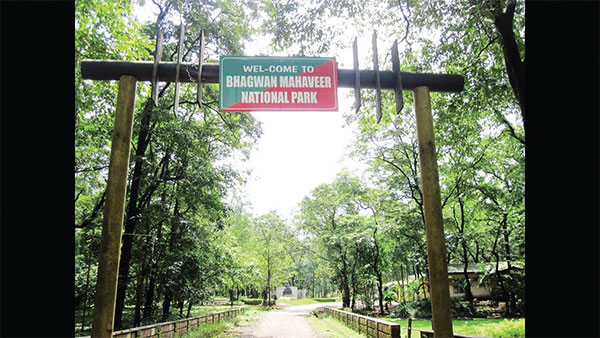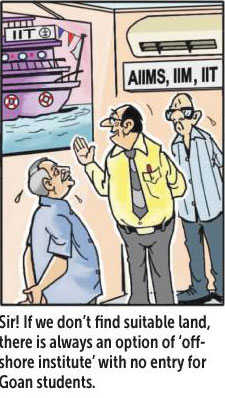23 Jun 2020 | 04:20am IST
Stakeholders of Goa’s biodiversity join hands to protect Mollem, Bhagwan Mahavir
Major stakeholders of not just tourism, but environment and biodiversity in Goa have started the citizen’s fight to protect the clearing of forest land at the Bhagwan Mahaveer Wildlife Sanctuary and Mollem National Park. The signatories are no-nonsense fighters for Goa and have pledged to not restrict themselves to just sending the letter but ensuring that the demands of people are met
Ajit John;
The
subject of tourism has always been one that excites much comment and the
increase of one’s temperature depending on which side of the fence one stood
on. However, there are times when the general public come together to express
their opposition to a move initiated by other parties or in this case the
government. A signature campaign against the clearing of forest land in Bhagwan
Mahaveer Wildlife Sanctuary and Mollem National Park for railway
double-tracking, widening of NH4A highway and laying of LILO transmission line
had evoked a strong response from various sections of society.
Sustainable tourism initiatives can help protect and preserve
biodiversity hotspots
The
Responsible Tourism Collective, a group of 16 businesses with decades of
experience, were already spearheading the sustainable tourism campaign in Goa
across sectors. The group felt with the help of private players, the
government could refocus and intentionally develop international standard
sustainable tourism initiatives to build on some of the existing programs of
the Forest Department like the annual Goa Bird Festival and monthly bird walks,
while at the same time creating and innovating solutions for the future.
They
pointed out the area’s
hinterland
nature-based tourism industry was growing and year-round revenue
source for the state. Across Bhagwan Mahaveer Wildlife Sanctuary and Mollem
National Park, there were a number of already existing eco-conscious
accommodations.
This
area which is protected, the letter pointed out was home to incredible
biodiversity, indigenous communities, and rich cultural heritage. It boasts of
hundreds of endemic species — animals, plants, and fungi. Being a tiger
habitat, in addition to a home for other apex predators and creatures on the
International Union for Conservation of Nature (IUCN) threatened list makes
this environment ideal for tourism and conservation programs to go hand in
hand. In addition to diverse fauna, the flora flourishes with freshwater
sources all around.
Three
important tributaries of the river Mhadei, which feeds into the Mandovi, Goa’s
lifeline, originates here, providing ample resources for exploration,
adventure, and guided experiences. There are also many local waterfalls like
Tambdi Surla Falls, Devil’s Canyon, and of course, Dudhsagar Falls, the main
tourist destination in Goa.
Aside
from the historic Mahadev temple of Tambdi Surla, more than 800 years old, the
area has more than a hundred sacred sites with stone sculptures and carvings
and other assets of archaeological and historical heritage. Researchers have
found stone tools and implements used by prehistoric humans though many are
still undiscovered and most are not documented or accessible to the public.
Biodiversity
conservation, which can be a major tourist attraction, requires locals for the
implementation of various programs. This is a great way for local communities
to become champions for conservation. With a well-developed state policy, a
sustainability certification program can bring about marked change and
growth. The benefits of developing sustainable hinterland tourism are for
everyone — revenue for the state, an increase in youth and local community
employment, and a rich cultural exchange promoting Goan traditional and local
culture.
The
letter ended with a fervent plea to revoke the decision to clear forest land in
Bhagwan Mahaveer Wildlife Sanctuary and Mollem National Park for railway
double-tracking, widening of NH4A highway and laying of LILO transmission line.
With
non-governmental organisations having already gone to court, one can expect a
long battle ahead though with courts having reduced their working timing, it
could be a while before it comes up for hearing.
What will the organisations in Goa do, to take their plea with
the Union Environment minister forward
At the State level, the Government should bring together local stakeholders or
groups (like the Responsible Tourism Collective, for example,) to help provide
recommendations and strategies that can be implemented on the ground
level. With public-private partnerships, we can work together to ensure
every aspect is carefully considered and the implementation of such programs is
effective and meets particular agreed-upon International-quality standards and
criteria to allow tourism to thrive in this rich and beautiful state-
Pooja
Rani Co-Founder Khoj-aao! Adventures
We are constrained right now due to the COVID problem. We are
unable to take any action on the ground due to section 144. The authorities are
taking advantage of the situation. Legal moves have been initiated to stop the
destruction of the forests-
Avertino Miranda Goa Green Brigade
They
have not even given an acknowledgment of our letter. This was a letter written
and signed by people who have a history of taking up causes for the benefit of
society. The authorities have been blatantly unresponsive-
Albertina
Almeida Advocate

